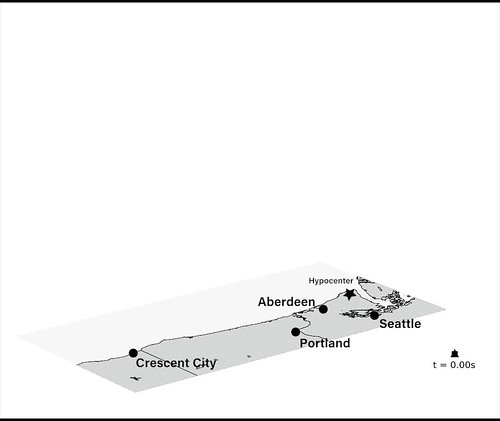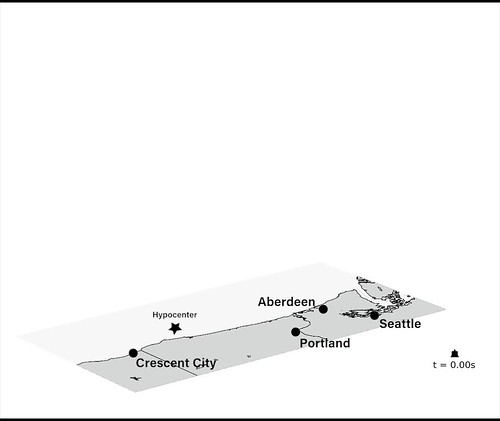Seismo Blog
Many people ask us “what is going on at Mount Rainier these days?” While we can say “an unusual number of earthquakes have occurred” the cause of them is not known for sure. A good conceptual model for “why” is that relatively minor changes in the hydrothermal (hot water) system at the core of the volcano have generated enough localized stress changes to break rock. Of course the breaking of rock causes shaking that we record as an earthquake. The U.S. Geological Survey’s Cascade Volcano Observatory (CVO) has a nice summary of this swarm and compares it to a previous one in 2009 from a volcanological point of view. In this blog we will deal only with the earthquakes and refrain from speculations about possible volcanic activity.
PNSN Earthquake Catalog
While there has been some seismic monitoring of the Mount Rainier area since the early 1970s it was not until about 1990 that stations were installed high on the cone allowing for detailed detection and location of earthquakes within the cone. The seismic network has grown over time until now there are 20 seismic stations on or near the volcano (3 at near 2.8 km elevation or 9,000’) that contribute to our monitoring data streams. When shaking is detected on more than four stations within a few seconds our computer systems are trained to declare an earthquake. Algorithms time the first arrivals (P-waves) and group them together for a standard location program to triangulate back to the source. It also estimates the event size or magnitude by the amplitude or duration of shaking. If the statistics on this automatic source location and magnitude estimate are good enough this earthquake is immediately reported to a public catalog on the PNSN web and the Comprehensive catalog (ComCat) which is hosted by the USGS. These events, as well as ones detected but not well automatically located are reviewed by an experienced human analyst. This review process inevitably results in a better estimate of each event’s location and size but takes time to produce. With earthquakes occurring many times per hour for days the manual analysis cannot keep up. A triage process is used to first analyze the larger or different looking events and then fill in smaller events when time allows. The result is that our catalogs change over time. Not only the most recent events but older events may change or be added as the manual analysis catches up. As of 10 days into the swarm about 1200 total events were recorded by the computer systems but only 780 have been manually analyzed leaving 420 still to do. Be patient. We are working over-time to catch up.
In the meantime here are some snap-shot summary plots of the locations of earthquakes made from our public catalog. One can use the analysis tools of our web system (use the “analyze” panel on the right of our map views) to update or make similar plots for this or other event selections as you wish.
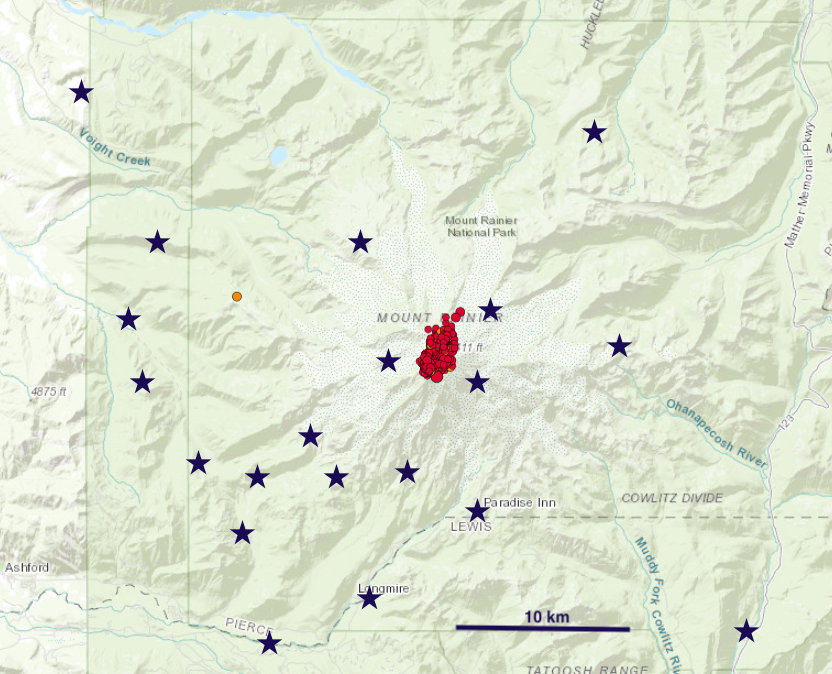
Map of 780 analyzed Rainier swarm earthquake locations (red circles) and the seismic stations used to locate them (stars).
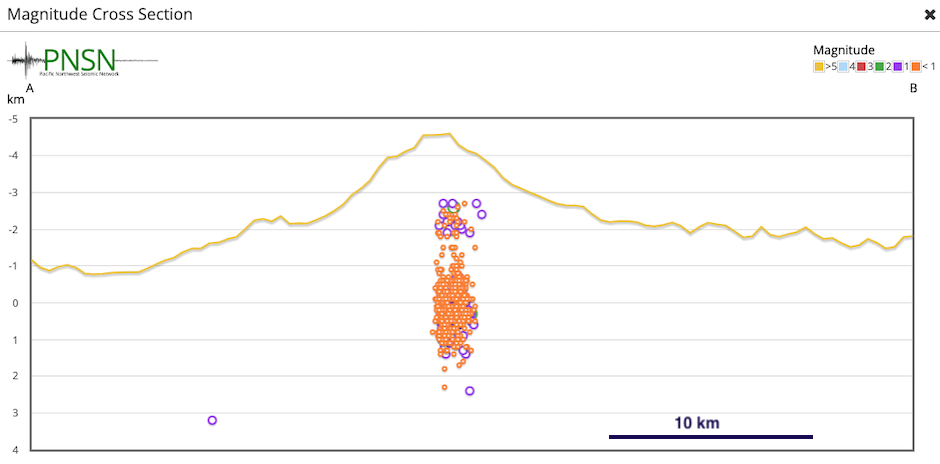
East-West cross-section of Rainier swarm earthquakes. Note that 0 km depth is sea level.
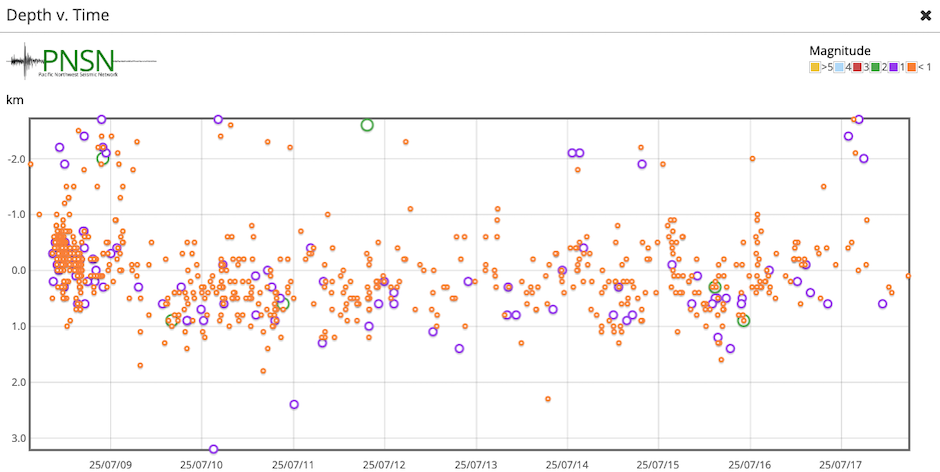
Time-depth plot of Rainier swarm earthquake starting on July 8, 2025
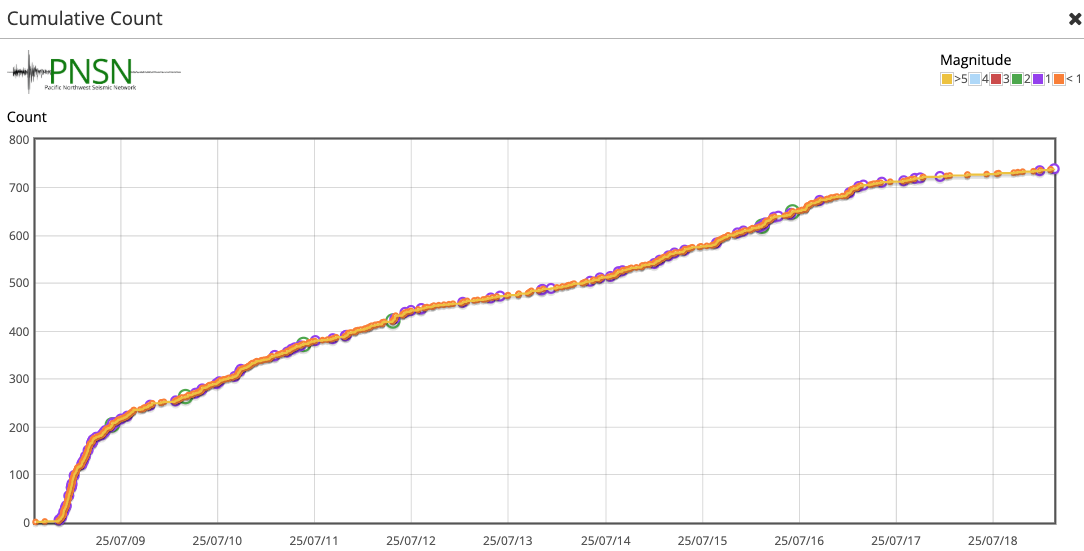
A plot of the cumulative number of earthquakes located in the Rainier swarm starting on July 8, 2025
Ongoing Scientific Projects -
Besides trying to keep up with the routine analysis of the detected earthquakes our science staff have been developing and implementing more advanced detection, timing and location procedures to allow us to look at the activity in more detail and perhaps more precisely than routine analysis allows.
REDPy -
A detection system that was developed by a previous graduate student has been running with configurations set up for several northwest volcanoes including Mount Rainier. This Repeating Earthquake Detector written in Python (REDPy) takes waveforms from a subset of PNSN stations, looks for deviations in signals, selects several seconds of waveforms at this point and then after filtering compares waveforms with all previously detected events. When it finds waveforms that match it groups the events into families that represent repeating or very similar earthquakes. When earthquakes break the same or very nearly the same rock the seismic waves generated should be nearly identical. Thus finding families of repeating earthquakes is indicative of the same or very similar chunk of rock breaking. What this means in terms of volcanic activity is of interest but not well understood. Thus far REDPy has found 48 different families, several with only two matching earthquakes, many more families with 10s of matches and 5 families with over 100 matches each. Some families have lots of matches early in the sequence, some mostly later in the sequence and a few have events throughout the sequence. There were over 2,000 total matches meaning that at least twice as many events have waveform matches than we have been able to individually locate.
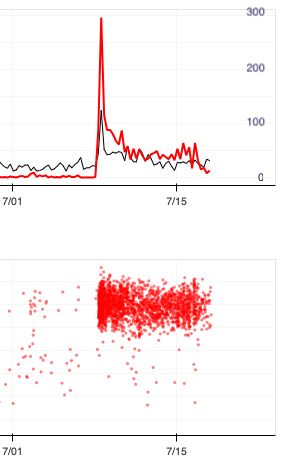
Section of a REDPy time plot showing: Top: the number of matches found (red) and non-matched detections (black) in a 6 hour window; Bottom: Relative quality of the match.
Template Matching -
Complementary to REDPy, we are applying another similarity-based detection method called Template Matching to seek out the smallest detectable earthquakes emanating from Mount Rainier. Whereas REDPy starts matching events after they are detected by just amplitude increases, template matching uses pre-specified examples (templates) taken from the waveforms of well located events and slides them across large swathes of seismic recordings, detecting matching pieces of the seismic record when the shapes of the waveforms on many channels align with one (or more) templates. If those templates are reasonably similar to earthquakes not previously detected, we have a very effective tool to find them.
We ran our first template matching analysis using 25 analyst reviewed and located earthquakes as templates on the afternoon of July 8th, detecting roughly 2200 candidate events over the 12 hours from the start of the swarm early that morning. Subsequent visual review confirmed roughly 95% of these detections were valid, though many were tiny earthquakes. We have continued to review, refine, and refresh our template matching analyses, incorporating more events and new data as they become available. The most recent analysis on July 17th used 423 analyst-reviewed earthquakes as templates and detected roughly 8,800 distinct events.
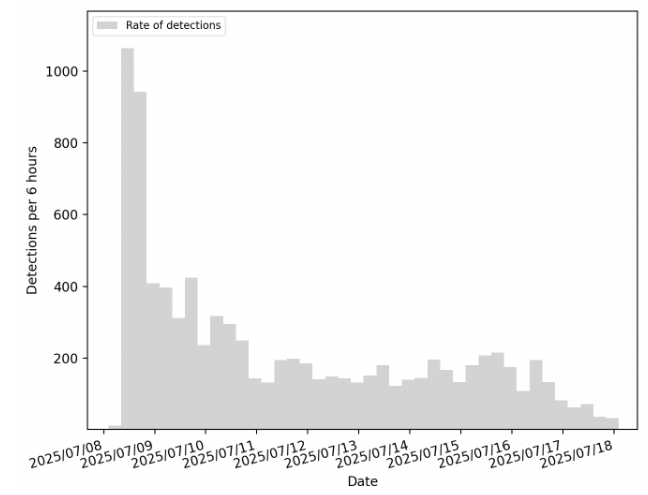
Plot of detection rates between July 8th and July 18th 2025. Detections are counted in 6-hour blocks and dates are in UTC time (subtract 7 hours to get local time).
High resolution earthquake locations
Our routine processing locates earthquakes one at a time using a simple one-dimensional seismic velocity model to calculate the travel times from source to seismic stations and a very traditional location program to invert for the latitude, longitude, depth and origin time of each earthquake. More modern location routines are available that can take advantage of having many different earthquakes in the same area to help account for a more complex seismic velocity structure (such as certainly exists in a volcano) and tiny errors in determining the arrival times of seismic waves. Some of these techniques are being tried with the Rainier swarm data but results are still too preliminary to cover in much detail here. A preliminary look at the results of one of these techniques (see below) confirms the general location for the events but shows that while the whole sequence is spread out over ~2.5 km in a NNE-SSW direction it consists of a number of more tightly clustered events into blobs, some only a few 100 meters across.
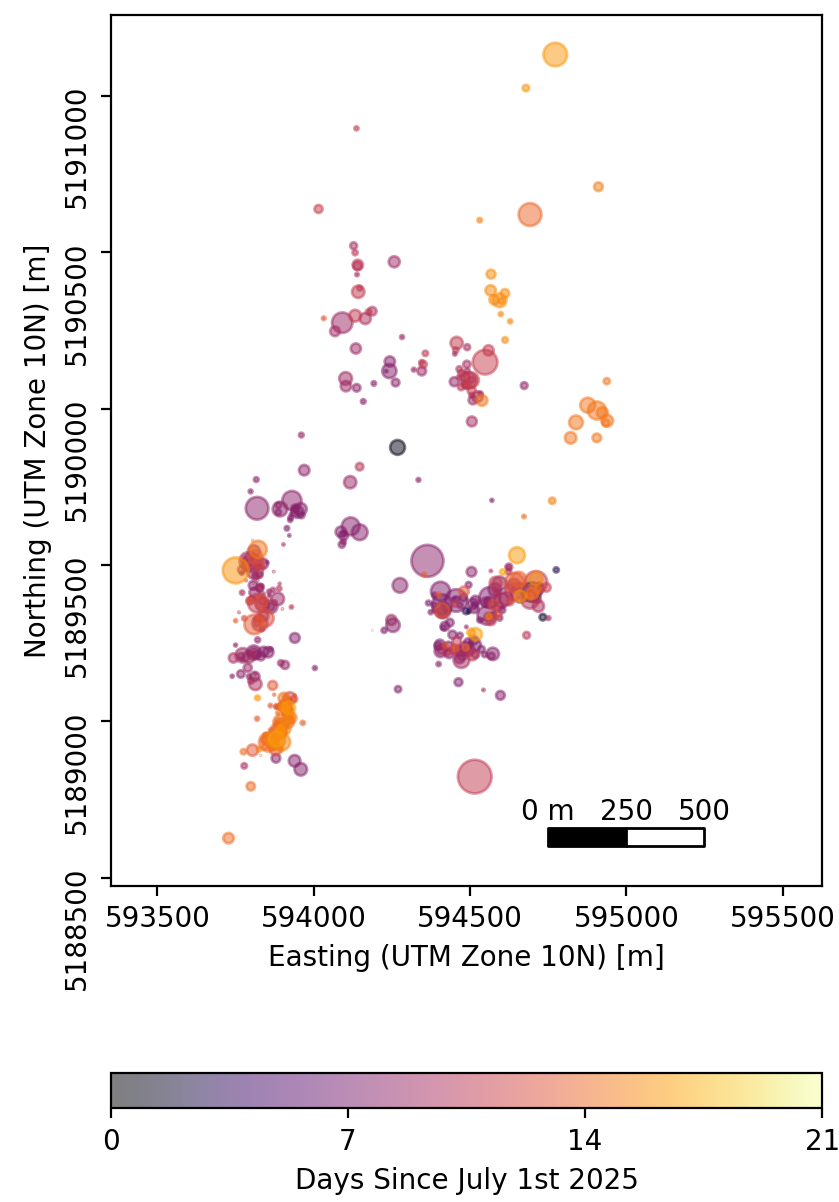
PNSN Web system redesign -
For the past year the IT and out-reach staff of the PNSN have been hard at work doing a major redesign of our web pages. While this process is ongoing and it may still be a few months before it is ready for public release there are some very nice new features that will be included. Besides an update of the basic content there are graphical display options that will let the general user view the results of our seismic monitoring in new, interesting and appealing ways. For example below is a static image of the current Rainier locations in a 3-D type view that when live will allow the user to rotate it to any desired orientation. There will also be ways to place indications of fault motion (focal mechanisms) on maps and cross-sections for groups of earthquakes.
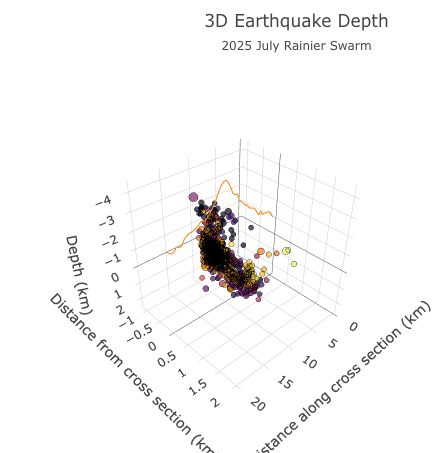
Stay tuned for more interesting research results and fun web page updates. Again, for volcanic hazards and updates refer to the USGS CVO update web pages.
Contributions from: Renate Hartog, Nate Stevens and Kyla Marczewski
Rumblings: Preparing for Cascadia - Documentary Screening and Discussion
January 7, 2025
by Kelly Missett
Swarms in Eastern Washington: are there fewer now than in the past?
September 25, 2024
by Renate Hartog
New Algorithm GFAST Enhances the ShakeAlert Earthquake Early Warning System
June 5, 2024
by Kelly Missett
Medford Schools Now Use Earthquake Early Warning Technology - And Yours Could Too!
December 13, 2022
by Kelly Missett
The MyShake app is now delivering ShakeAlert-powered alerts in Washington
January 26, 2022
by Gabriel Lotto
What can the recent Kentucky tornado disaster teach us about earthquake early warning?
December 17, 2021
by Paul Bodin
Blanco Fracture Zone swarm: Active, unusual, interesting... but not concerning
December 10, 2021
by Alex Hutko
December 2017 Oregon Tremor Event
Over the past 9-10 days, it appears that tremor in central Oregon has picked up (Figure 1). The last slow slip and tremor event was in February 2016, 22 months ago.
Figure 1
Figure 1. Age progression of tremor in central Oregon for the past 9 days. Earliest tremor locations start from 12/5/2017 and propagate roughly outward, clustering near Salem and Roseburg. Last update was December 14, 2017.
Tremor is the release of seismic noise from slow slip along the interface of the Juan de Fuca and North American plates and lasts for several weeks to months. This process is known as Episodic Tremor and Slip (ETS). Slow slip happens down-dip of the locked zone (Figure 2). The locked zone is where tectonic stress builds up until it releases in a great earthquake or megaquake. The recurrence interval of slow slip and tremor varies at different regions along the Cascadia Subduction Zone.
Figure 2
Figure 2. Cross section of the subducting Juan de Fuca Plate. Figure from Vidale, J. and Houston H. (2012) Slow slip: A new kind of earthquake (Physics Today, 2012 pages 38-43).
The last ETS event in Cascadia started in February 2017 around the western edge of the Olympic Mountains. The duration was approximately 35 days with a two-week quiescent period. Prior ETS events in northern Washington/Vancouver Island area was approximately December 2015.
The last ETS event in central Oregon was 2016 and lasted just over a week before it stopped on March 1, 2016.
ETS events are still being studied to understand the processes about slow slip and megathrust earthquakes.
More information about slow slip and tremor can be found here on the PNSN website.
Tremor has continued in Oregon since the last post on December 15th. Current tremor activity has been ongoing since about 12/5/2017 (figure 1).
Figure 1
Figure 1. Age progression of tremor in central Oregon for the past two weeks. Earliest tremor locations start from 12/5/2017 and propagate northerly and southerly. Last update was December 26, 2017.
Since December 19th, tremor has now migrated northerly toward Portland and southerly toward Medford (figure 2).
Figure 2
Figure 2. Tremor activity from 12/19 to 12/26 showing progression in a northern and southerly direction.
More FAQs on Slow Slip and Tremor
On our previous blog post, we briefly discussed what ETS (episodic tremor and slip) is. Let’s go through a couple of more frequently asked questions.
1.What is tremor?
Tremor in the Cascadia Subduction Zone is the seismic noise of slow moving earthquake along the interface of the subducting Juan de Fuca Plate and the North American plates. Compared to normal earthquakes, tremor has lower frequency energy and can last for minutes, hours or weeks.
2. What about volcanic tremor?
Tremor can also be volcanic. But ETS is deep, non volcanic signatures that are a result of plate motion, not magmatic movement.
3. How deep are the tremors?
As it states on our website - “This is a topic of ongoing research.” But research suggests that it occurs near the plate interface at approximately 30 - 40 km deep.
4. What is the magnitude of tremor?
Tremor is probably made up of many tiny individual earthquake-like sources each with a "magnitude" of less than 1. Since tremor is an on-going continuous signal assigning a magnitude to it is never done.
Check out the map on our web page:
In the previous blog post about The M9 Project, we talked about how the Cascadia Subduction Zone can generate an M9.0 earthquake. However, our understanding of what an earthquake of this scale would actually look like is less advanced. While we have evidence of past earthquakes (e.g., native oral histories, tsunami records), we have no quantitative observations of how strong the shaking would be during a megathrust earthquake in the Pacific Northwest.
To address this problem, researchers with The M9 Project used 3D computer simulations to help understand what 50 different realizations of an M9.0 earthquake could look like in Cascadia. To create these simulations, The M9 Project researchers used multiple supercomputers: Stampede (University of Texas - Austin), Constance (Pacific Northwest National Lab), and Hyak (University of Washington). A single earthquake simulation took up to 46 hours to complete. If it was possible to run these earthquake models on a personal computer (many of which have a mere 2 processors, compared to the 576 processors used to run these simulations on a supercomputer), it would take about 522 days to complete one simulation.
Why are earthquake simulations important?
The unique properties of the Cascadia Subduction Zone prevents a side-by-side comparison between a future Cascadia earthquake, and other earthquakes that have occured around the world. For instance, an M9.0 earthquake in Japan, Chile, or Indonesia may look very different from an M9.0 in the Pacific Northwest.
Scientists have developed equations that can estimate the strength of ground shaking based on an earthquake’s magnitude and a specific location’s distance from the fault. However, these equations still rely on averages, and do not fully account for location specific 3-D effects (i.e., “How will seismic waves bounce around in the Seattle basin?”). Conversely, the supercomputer earthquake simulations, while still having some unknowns, can estimate shaking at every point in the Pacific Northwest, and are specific to the geologic conditions of the Cascadia Subduction Zone.
How are these earthquake simulations created?
Out of an infinite number of possibilities, 50 simulations of an M9.0 earthquake were run by The M9 Project team. The individual earthquake scenarios had a few important variations between them, that made each earthquake source unique: (1) the hypocenter location (i.e., where the earthquake starts), (2) how far inland the rupture extends (i.e., how close the earthquake gets to major inland cities, such as Seattle), (3) the location of “sticky patches” on the fault, that generate the strongest ground shaking, and (4) the slip distribution on the fault (i.e., how far certain areas on the fault move during the earthquake).
Are certain earthquake scenarios “better” or “worse”?
The area affected by a megathrust earthquake is large enough that the outcome is going vary by location. A “best-case” scenario for one area in the Pacific Northwest could be a “worst-case” scenario somewhere else in the region.
One of the results of the computer simulations showed that when an M9.0 earthquake occurs on the Cascadia Subduction Zone, less violent shaking may be felt closer to the epicenter. This is because an earthquake on the Cascadia Subduction Zone will not occur at a single point -- instead, it will rupture a very large area. As the rupture moves along the fault, the seismic waves will start to “pile up,” similar to the Doppler Effect.
As the waves at the front of the rupture combine, their amplitudes get larger and create more violent ground motion. Therefore, locations closer to the hypocenter may receive less complex and destructive seismic waves than locations that are farther along the rupture and experience this “piling-up” of seismic energy.
In these two videos, notice how Seattle's mock seismogram has larger spikes (which denotes stronger ground motion) when the earthquake source is farther south, and the fault ruptures north.
This variation by location makes it virtually impossible to award a scenario the title “best-case” for the entire Pacific Northwest.
Can we do even better?
These computer simulations are the most accurate representations of what an M9.0 earthquake would look like in the Pacific Northwest. Unfortunately, there is a lot of variability in these calculations because there are still too many unknowns. An increase in seismic and GPS instrumentation throughout the Pacific Northwest, especially offshore, will help us identify more specifics about the Cascadia Subduction Zone and improve future computer simulations. For instance, we may be able to determine where “sticky patches” are located on the fault and obtain a more detailed image of the 3D structure of the subduction zone. Further constraining these variables in the computer simulations will ultimately help us refine our estimates of seismic hazards in the Pacific Northwest.
Special Thanks To
Dr. Erin Wirth, UW Affiliate Assistant Professor
M9 Simulation coverage from UW News
We are going to have The Big One. That’s a fact.
The final blog about The M9 Project is going to focus on you. What are you going to experience during a megathrust earthquake? How do we connect science and community? What should you do to be prepared?
The Next Stages of The M9 Project
Seismologists are not the only contributors to The M9 Project. Civil engineers, urban design and planners, statisticians, social scientists and public policy researchers also play a role in determining earthquake risk, safety measures, and public response to hazards.
Understanding the hazards and mechanisms of an earthquake is one thing, communicating effectively to the public is a completely different ball game. The next steps of The M9 Project focus on how we define and discuss hazards with communities.
For example, how does the way we design hazard maps affect how communities approach hazard planning? (See photo below) Or, how can hazards planning be steered towards rebuilding to community-specific values?
From assessing the utility of hazard maps (see image below), to hosting community planning workshops , The M9 Project’s research into “long term” preparedness- mitigation, response, and recovery focuses on how to best help you. We will discuss what to expect when the big one hits, as well as some resources so you can take steps to prepare .
Learning about Cascadia from other Large Earthquakes
The last megathrust earthquake on the Cascadia Subduction Zone occurred in 1700 AD, before written records were kept in the region. In addition to The M9 Project research at UW, we can also look to observations of other major earthquakes worldwide, to help us predict what The Big One may look like in the Pacific Northwest.
Ground Shaking
A magnitude 9 earthquake will generate very strong shaking for several minutes. The intensity, measured by the Modified Mercalli Intensity Scale (MMI), is determined by observations during an earthquake. Shaking tends to decrease farther away from the fault and will vary with local soil conditions, so intensity will vary by location. A more detailed description on intensity can be found here.
Below is a comparison of the shaking intensity from the 2001 Nisqually earthquake, compared to a hypothetical M9.0 earthquake scenario. A megathrust earthquake will be felt over a much larger area, and generate stronger shaking.
You can find more about how magnitude and intensity are related here.
As part of The M9 Project, UW civil engineers are researching building response to strong ground shaking from a magnitude 9.0 earthquake in Seattle. This video from Kinetica Dynamics shows skyscrapers in Tokyo shaking from the 2011 M9.0 Japan earthquake.
Tsunami
Large earthquakes on a subduction zone are capable of generating large tsunamis. For example, the 2004 M9.1 Sumatra earthquake resulted in a 30+ meter high tsunami on the west coast of Sumatra (source). For more about tsunamis, visit our tsunami overview page.
This NOAA video models the tsunami from the 1700 Cascadia earthquake, which caused damage and loss of life as close as the west coast of North America, and as far away as Japan.
We expect the next great Cascadia earthquake to be similar. As mentioned in our first M9 Project blog post, the record of past megathrust earthquakes can be found in muddy estuaries on the coast of the Pacific Northwest. In the layers of coast that have subsided and been filled again, there are bands of sand brought inland by tsunami waves, time and time again. Here is a article written by the American Museum of Natural History with more information on the Ghost Forests on the PNW.
Liquefaction
For liquefaction to occur, three things must happen. (1) Young, loose and grainy soil (2) needs to be saturated with water, and (3) experience strong ground shaking. The USGS, in coordination with California Geological Survey, give a summary of liquefaction and its effects here.
This video from the 2011 M9.0 Japan earthquake shows dramatic cracks in the ground, as well as liquefaction.
Our webpage on liquefaction includes video of the 2011 Christchurch earthquake, as well as links to liquefaction hazard maps for Washington and Oregon.
Landslides
Strong shaking can increase susceptibility to landslides.
This blog from the American Geophysical Union details some of the significant landslides in Paupa New Guniea that were triggered by a M7.5 earthquake on February 25th, 2011.
The Pacific Northwest is susceptible to landslides due to seasonal conditions, and strong shaking will increase landslide risk. Here are some resources from the states of Washington and Oregon.
Building Damage and Fires
The 1989 Loma Prieta earthquake caused widespread damage to infrastructure, such as the collapse of the Cypress Viaduct in Oakland, and fires in the San Francisco area.
Major cities in the Pacific Northwest would be just as susceptible to fire damage, and the construction of the Cypress Viaduct bears a striking resemblance to Seattle’s Alaskan Way Viaduct.
So, What Can I Do?
In order to prepare effectively, it is important to be aware of all earthquake-related hazards, such as the ones listed above. The following websites are great resources for earthquake hazards and preparedness in the Pacific Northwest. We encourage you to know your risks, be prepared, mitigate against hazards, respond safely, and enagae in holistic recovery planning.
- Cascadia Regional Earthquake Workgroup (CREW)
- Washington State Emergency Management Division
- State of Oregon Emergency Management
- Emergency Management British Columbia
- Become a Community Emergency Response Teams member
- Become a Red Cross Volunteer
- Check your local emergency management office for information specific to your community!
In the event of an earthquake, don't forget to drop, cover and hold!
Special Thanks To
Dr. Erin Wirth, Affiliate Professor, University of Washington
Lan T. Nguyen, Doctoral Student, Interdisciplinary Urban Design and Planning, University of Washington
On May 18th, 1980, at 8:32 AM, the landscape in Southwestern Washington was forever changed by an explosive eruption of Mount St. Helens. This was the most deadly volcanic event in US history.
Mount St. Helens is part of the Cascade Range, a chain of volcanoes from British Columbia to Northern California. The PNSN and the Cascades Volcano Observatory cooperatively operate 21 seismometers on or near Mount St. Helens, the most historically active volcano in the Cascade Range.
Seismogram of May 18th from one of our seismic stations.
Main PNSN Page on Mount St. Helens
Main CVO Page on Mount St. Helens
On the anniversary of the eruption of Mount St. Helens, earth science gets its day in the spotlight. Here's a collection of news stories about the eruption and what we have learned about volcanoes since 1980.
38 years later: What's changed since the Mount St. Helens Eruption?
- Q13 News
Features an interview with PNSN DIrector Emeritus Steve Malone
Mount St. Helens: Remembering the deadliest U.S. eruption 38 years later
- USA Today, King 5 News
Summary of events on May 18th, 1980 with photo galleries
Lessons Learned: Mount St. Helens to Kilauea
- King 5 News
Interview filmed in the PNSN Seismology Lab with Director Emeritus Steve Malone
Remembering Mt. St. Helens as Cascade event looms
- KOIN 6
Event overview, brief discussion of Cascade hazards, and dispels concern of a Kilauea-triggered event in the Cascades.
Photos: The Mt. St. Helens eruption of 1980
- KOIN 6
Includes an interview with CVO Scientist-In-Charge Seth Moran
Scientists Reflect on the Catastrophic 1980 Mount St. Helens Eruption
- Ashley Williams, AccuWeather
Details about the activity that led to the eruption, how life in the MSH area fared, and another Steve Malone feature.
How Dangerous are the Northwest's Volcanoes?
-KUOW, Oregon Public Broadcasting
Interview with CVO Scientist-In-Charge Seth Moran, discusses Oregon volcano hazards
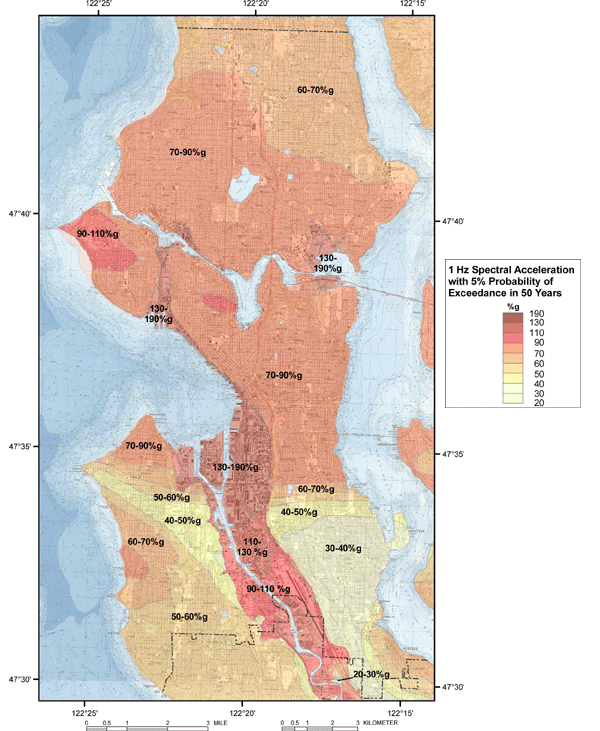
Background: The Challenges of Predicting Seismic Hazard
We all want to know when the next big earthquake will happen. But because we can’t predict earthquakes, the next best thing we can do is figure out how strong shaking could be during future quakes. To do this, earth scientists can reconstruct an area’s historic earthquake record using geologic markers and any available written accounts, which allows them to constrain recurrence and magnitude ranges for quakes on local faults. Scientists then combine these estimates with what we know about an area’s surface geology to predict how often and how strong the ground will shake during an earthquake. This sort of analysis is the basis for the US’ National Seismic Hazard Mapping Project, and it is critical for making sure we build structures that can withstand earthquake shaking.
Predicting how an earthquake will shake an area is not a trivial task, however. Besides the challenges of figuring out the historical earthquake record from sparse geologic markers, understanding how conditions at a given location will affect earthquake shaking is very difficult. In Seattle, for example, there are many interesting geologic features that change and amplify ground motion during earthquakes; large areas of water-logged, artificial fill under Pioneer Square and SODO have amplified ground motion and even liquefied during historic earthquakes; the deep Seattle Basin, which contains thick layers of relatively soft sediments, traps seismic waves and “sloshes” like a big bowl of jelly in some earthquakes. Taking these effects into consideration during seismic hazard analysis is important, but requires a detailed understanding of the local geology and how it affects seismic waves.
The hills are alive with the sound of … earthquakes?
A geographic component that is not often considered during seismic hazard analysis is topography. As seismic waves from an earthquake propagate through the earth, they interact with subsurface geology, like faults and basins; however, the waves also interact with surface features, like hills, cliffs, and valleys. Depending on the wavelength of the seismic waves and the direction they’re traveling, the shaking felt on these features can be much stronger (or weaker!) than in surrounding flat areas. This amplification happens because these features scatter and trap seismic energy; they can also experience a sort of structural “resonance”, similar to the way buildings and bridges can. Studies of ground motion from the 2009 L’Aquila and 2010 Haiti earthquakes [1, 2] have shown that topography significantly amplified ground motion at certain locations, sometimes shaking twice as strong as surrounding areas!
With these findings in mind, we are interested in seeing how topography might affect earthquake shaking here in Seattle. While the city doesn’t have any particularly tall or prominent ridges, it does have many steep bluffs and cliffs overlooking Elliott Bay and Puget Sound. We know from past earthquakes that these features are prone to land-sliding, and we would like to know how topographic amplification might contribute to that hazard, as well as to the general safety of structures built on the bluffs.
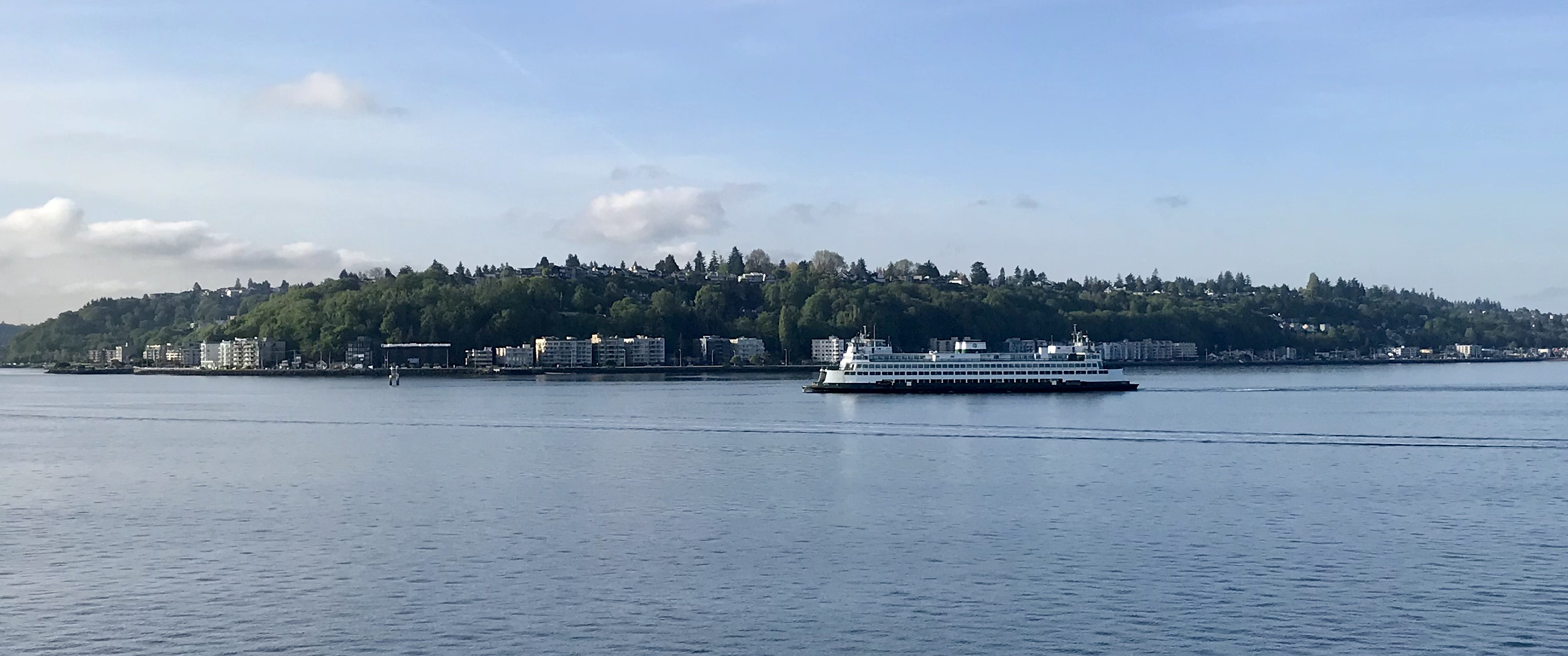
How will the 70-90m tall bluffs around the city behave in an earthquake?
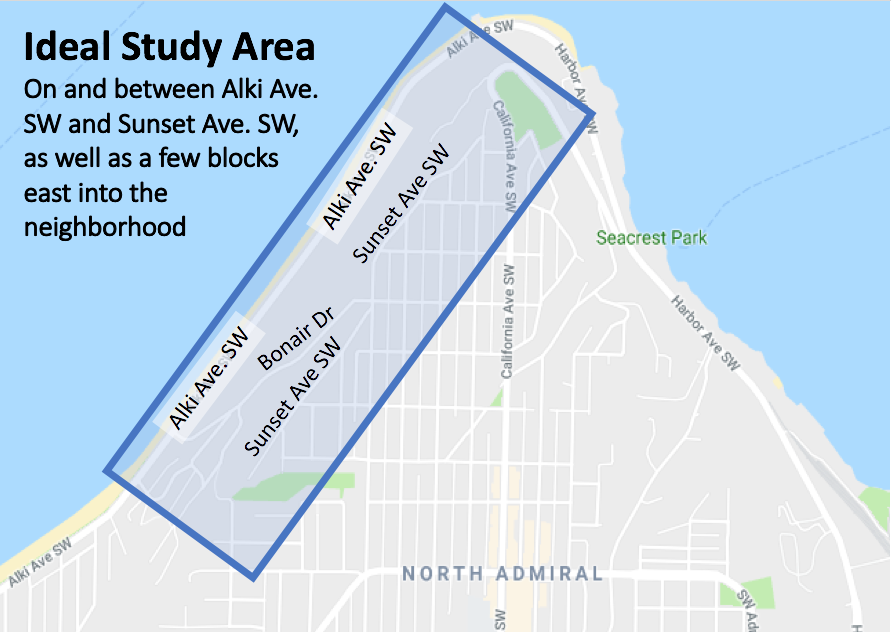
How will things shake out in West Seattle?
So, as part of a graduate-student-led research project, we are looking for volunteers in West Seattle to host seismometers for a small experiment. In this project, portable seismometers will be placed along and down the bluffs facing Puget Sound. Over the course of a few hours, these seismometers will record the ambient vibrations caused by ocean waves, weather systems, and even car traffic. Together, these sources create what’s known as ambient seismic noise. By comparing recordings of this noise from points along the bluff, we can understand how the topography amplifies ground shaking during earthquakes.
For our experiment, we are looking for hosts in West Seattle living near the bluffs along Alki. Ideally, hosts would live on or between Sunset Ave. SW and Alki Ave. SW. We also need a few sites in the neighborhood away from the sea bluff (see the map below). The experiment itself will last just 1 day, and only requires access to your yard, where we will plop-down a coffee-can sized seismometer for a few hours. The experiment will take place some time between early October and late November.
So, if you are a citizen scientist who would like to help us better understand how earthquakes rattle the hills around our city, and you live on or near the Sound-facing bluffs in West Seattle, please consider filling out the form linked below!
If you have any questions about the experiment, you can contact the project lead Ian Stone at ipstone@uw.edu
Link to Sign-up Form: https://forms.gle/vfSBgpZUapbKs5eo7
References
[1] Massa, M., Lovati, S., D’Alema, E., Ferretti, G., and M. Bakavoli, 2010. An experimental approach for estimating seismic amplification effects at the top of a ridge, and the implication for ground-motion predictions: The case of Narni, Central Italy. Bul. Seis. Soc. Amer., 100 (6) 3020-3034.
[2] Hough, S. E., Altidor, J. R., Anglade, D., Given, D., Janvier, M. G., Maharrey, J. Z., Meremonte, M., Mildor, B. S. L., Prepetit, C., and A. Yong, 2010. Localized damage caused by topographic amplification during the 2010 M 7.0 Haiti earthquake. Nature Geoscience, 3. 778-782.
